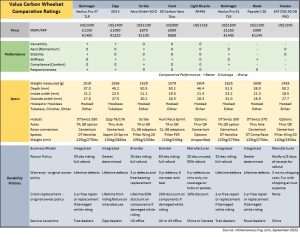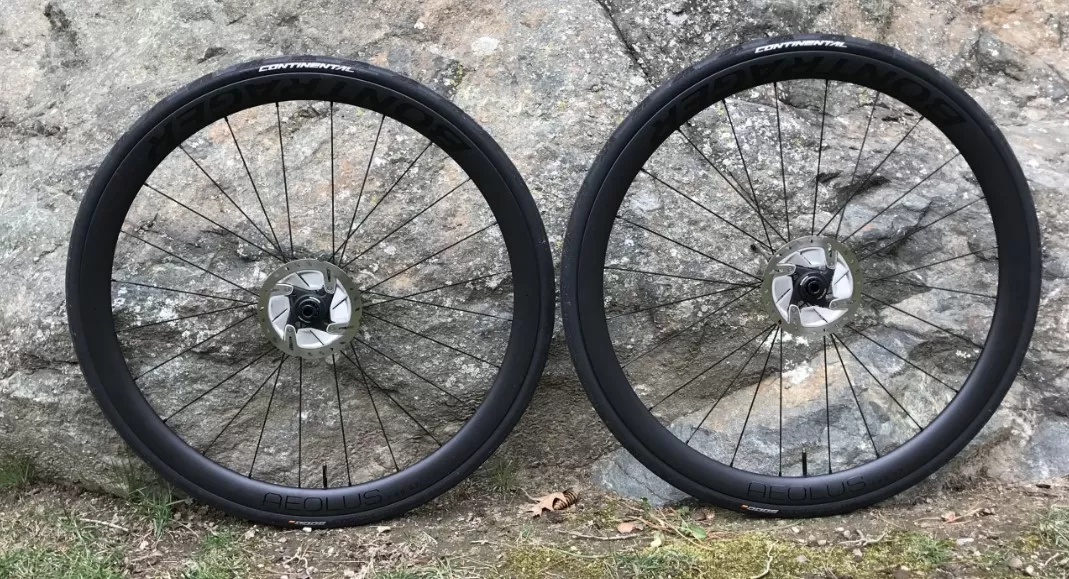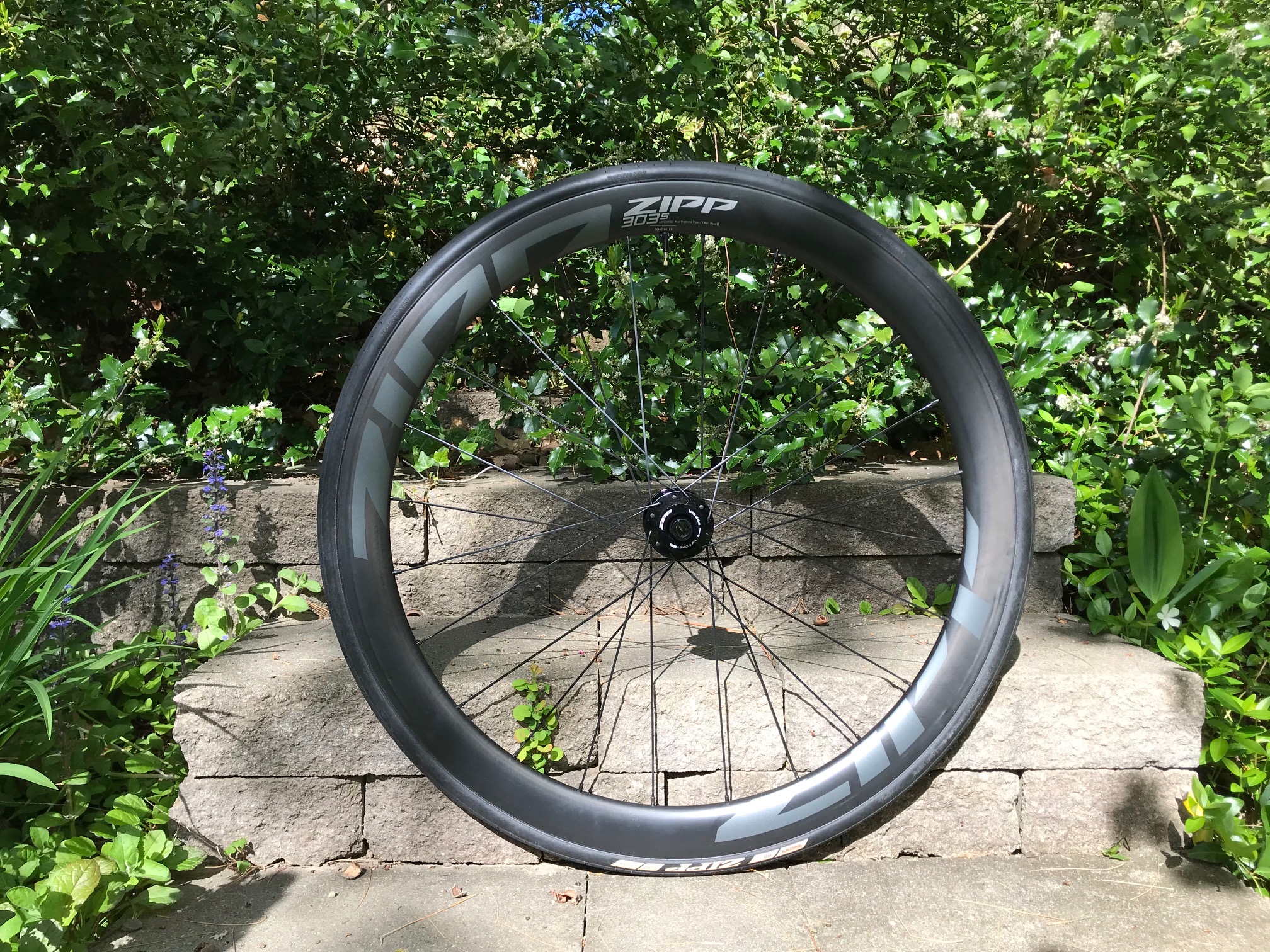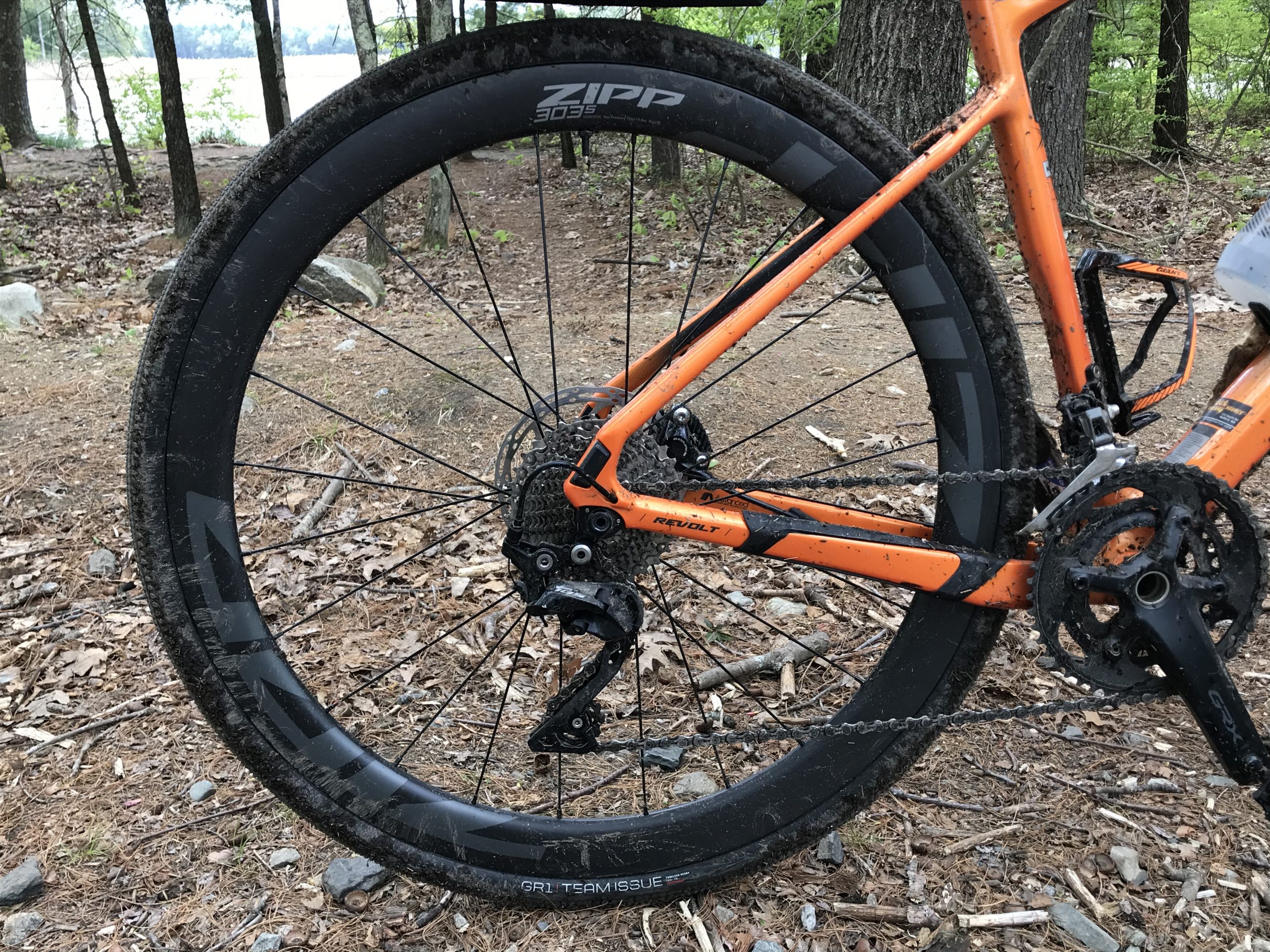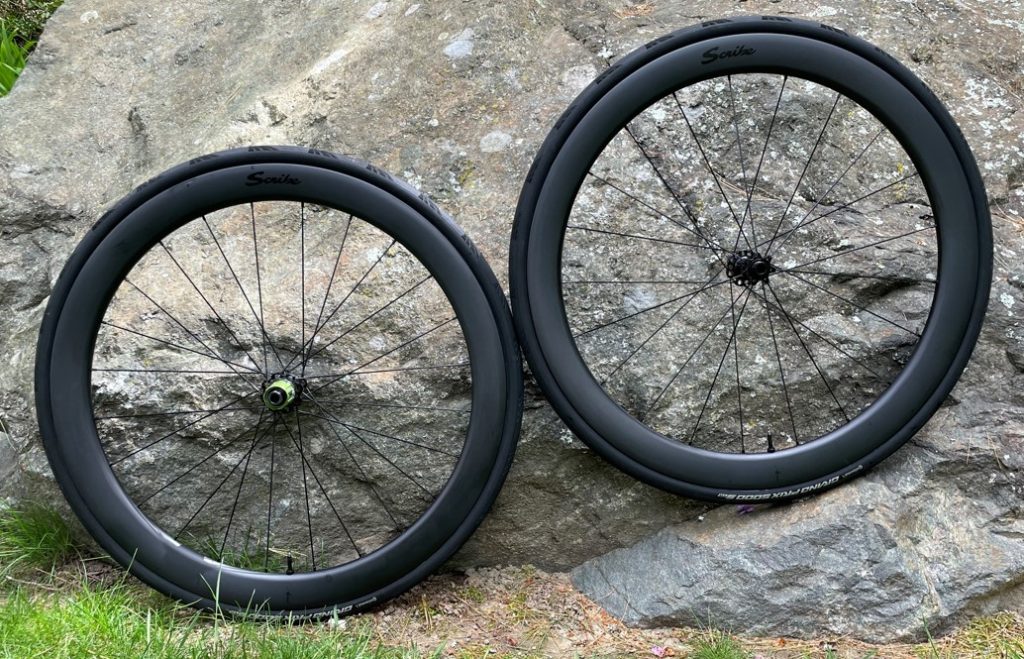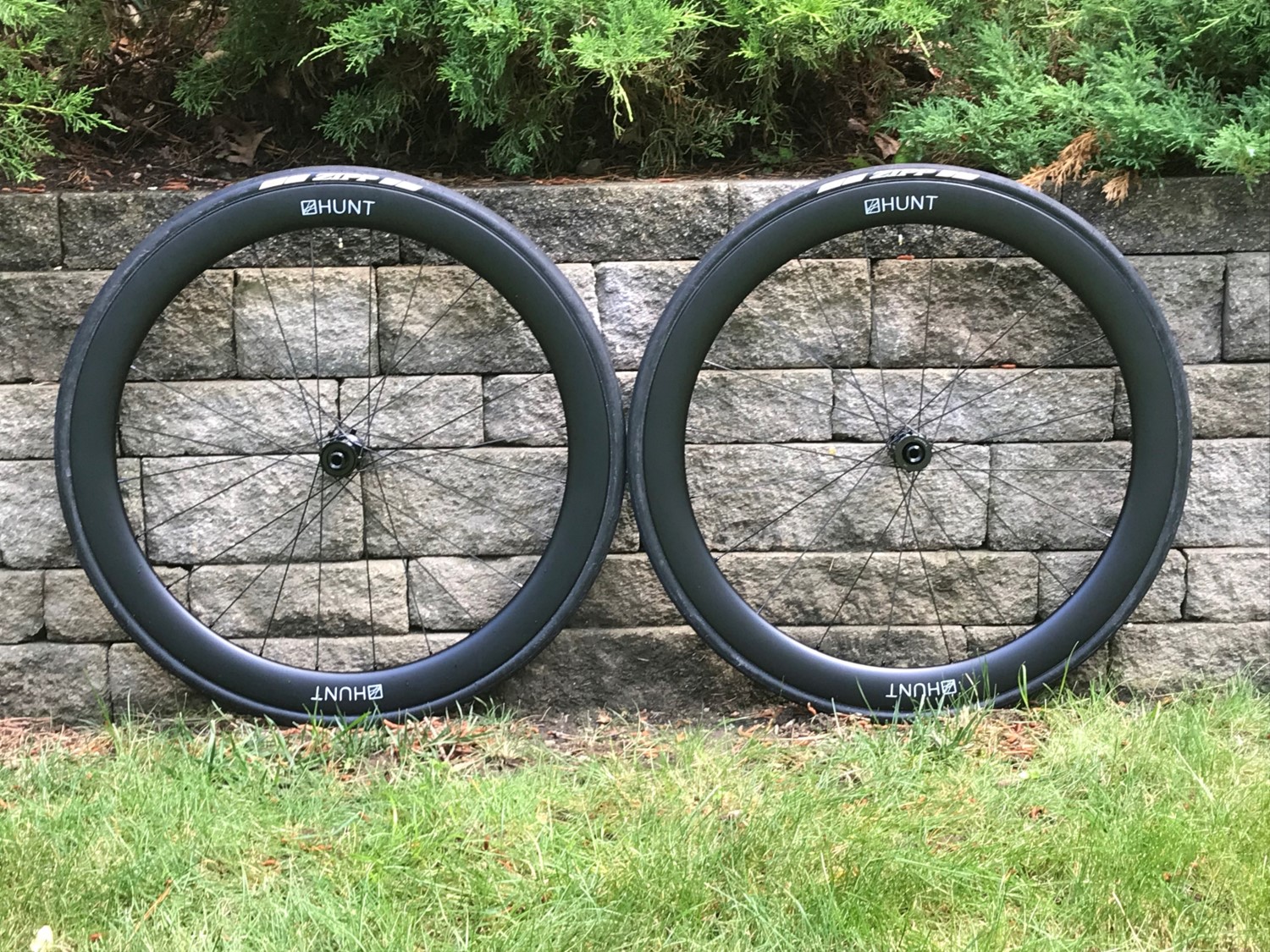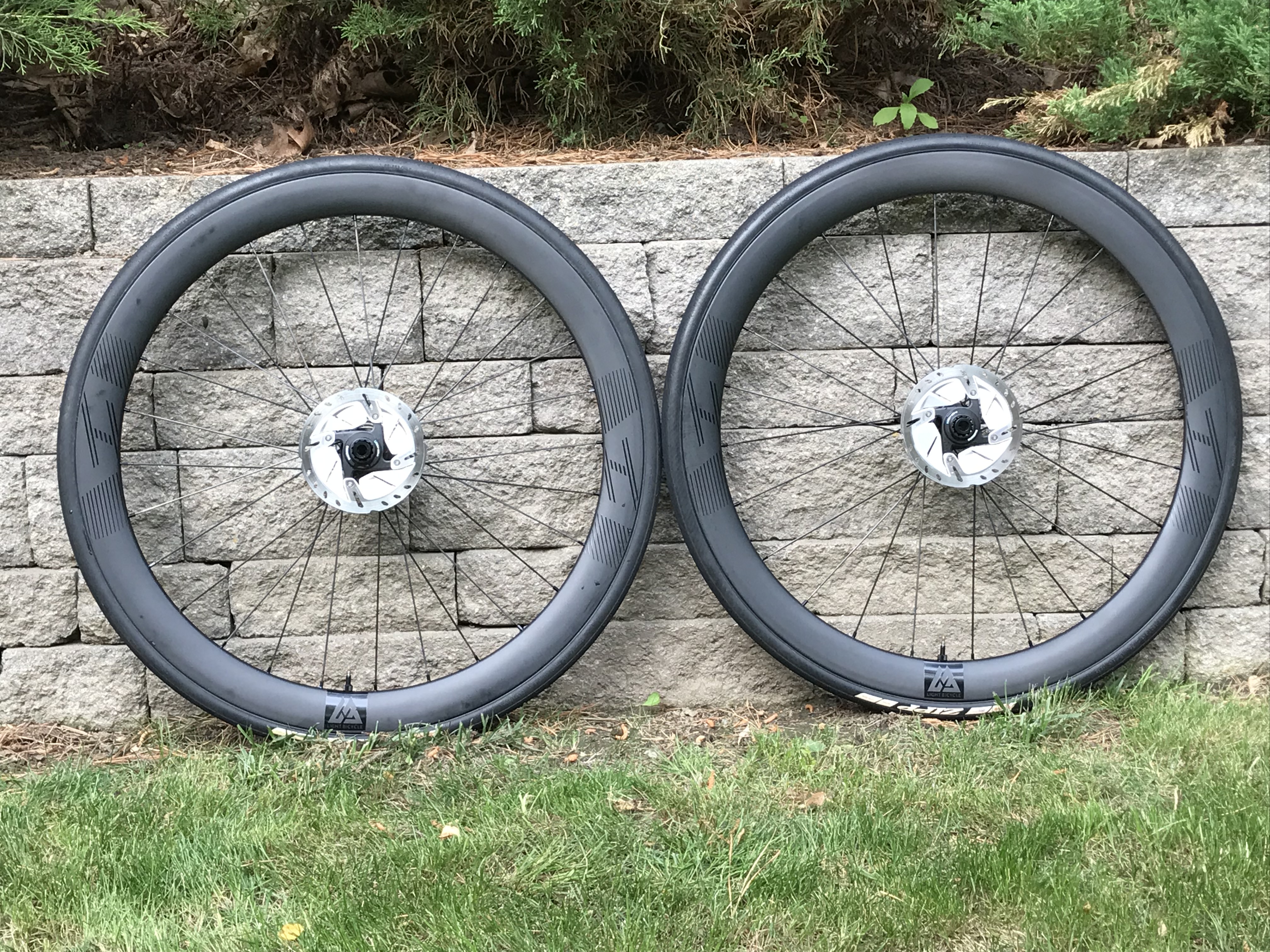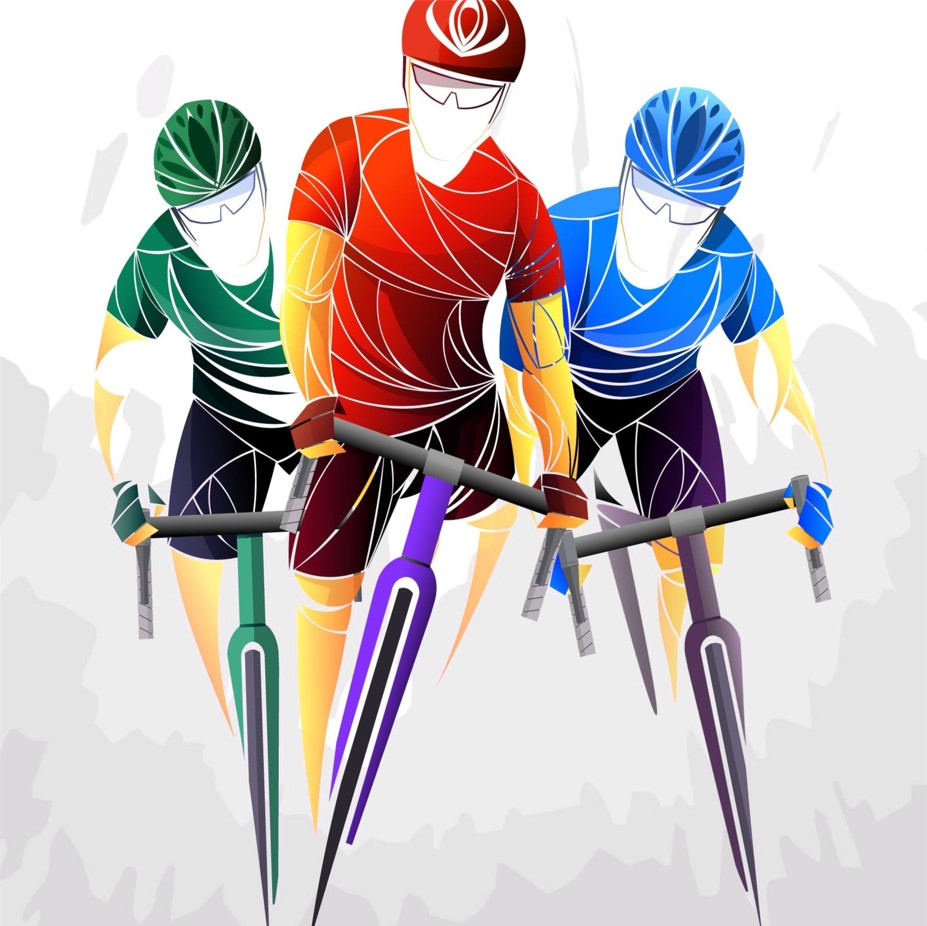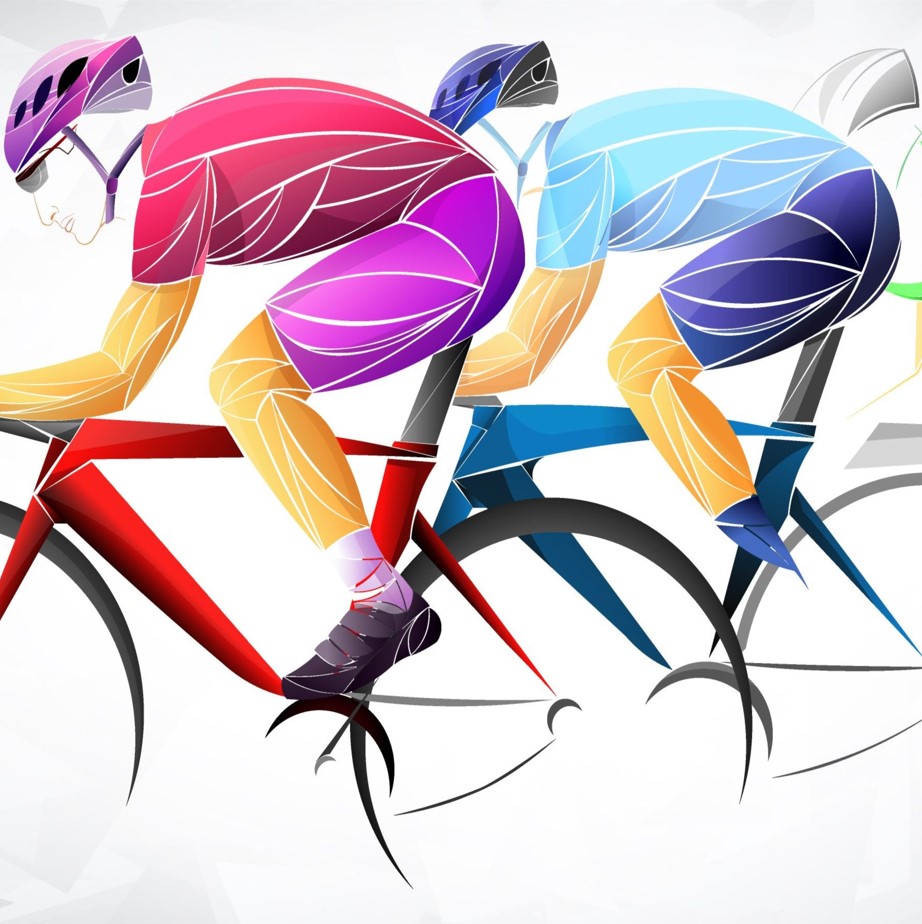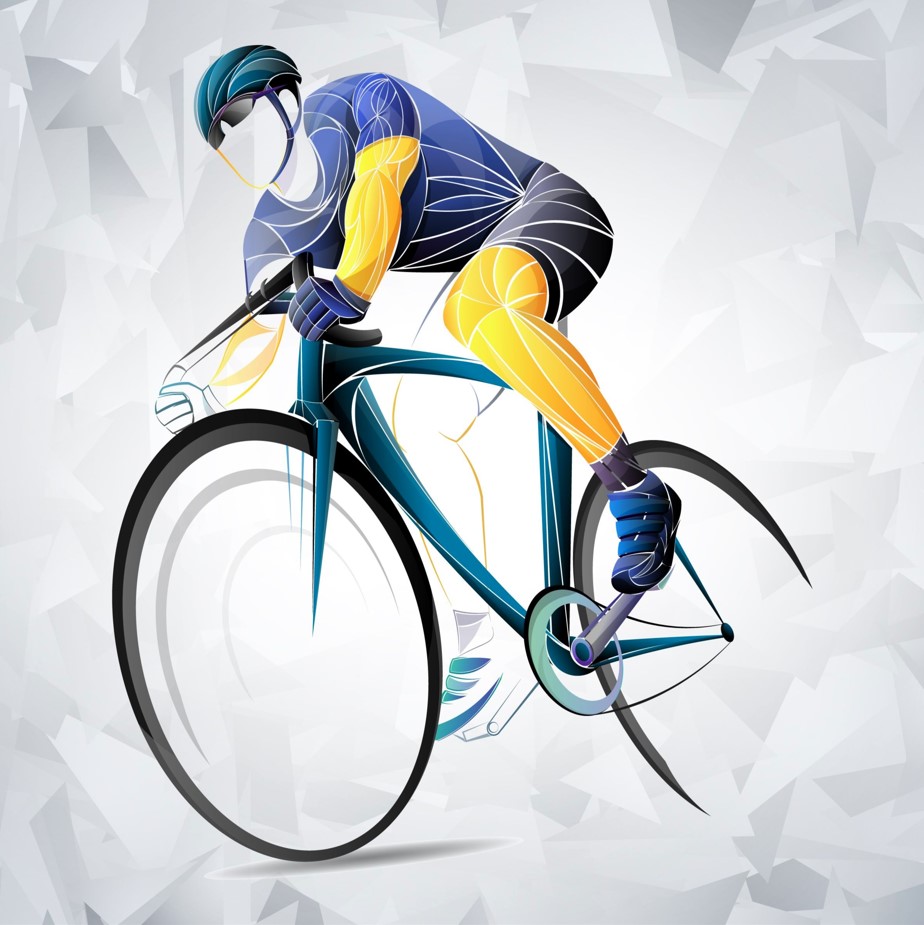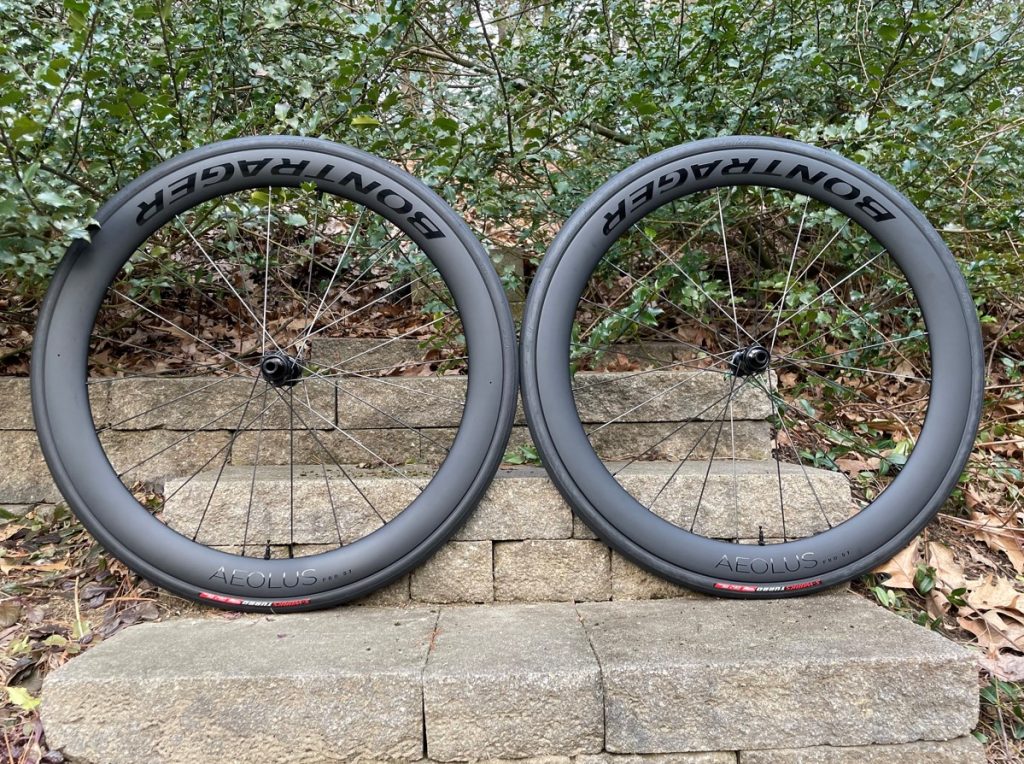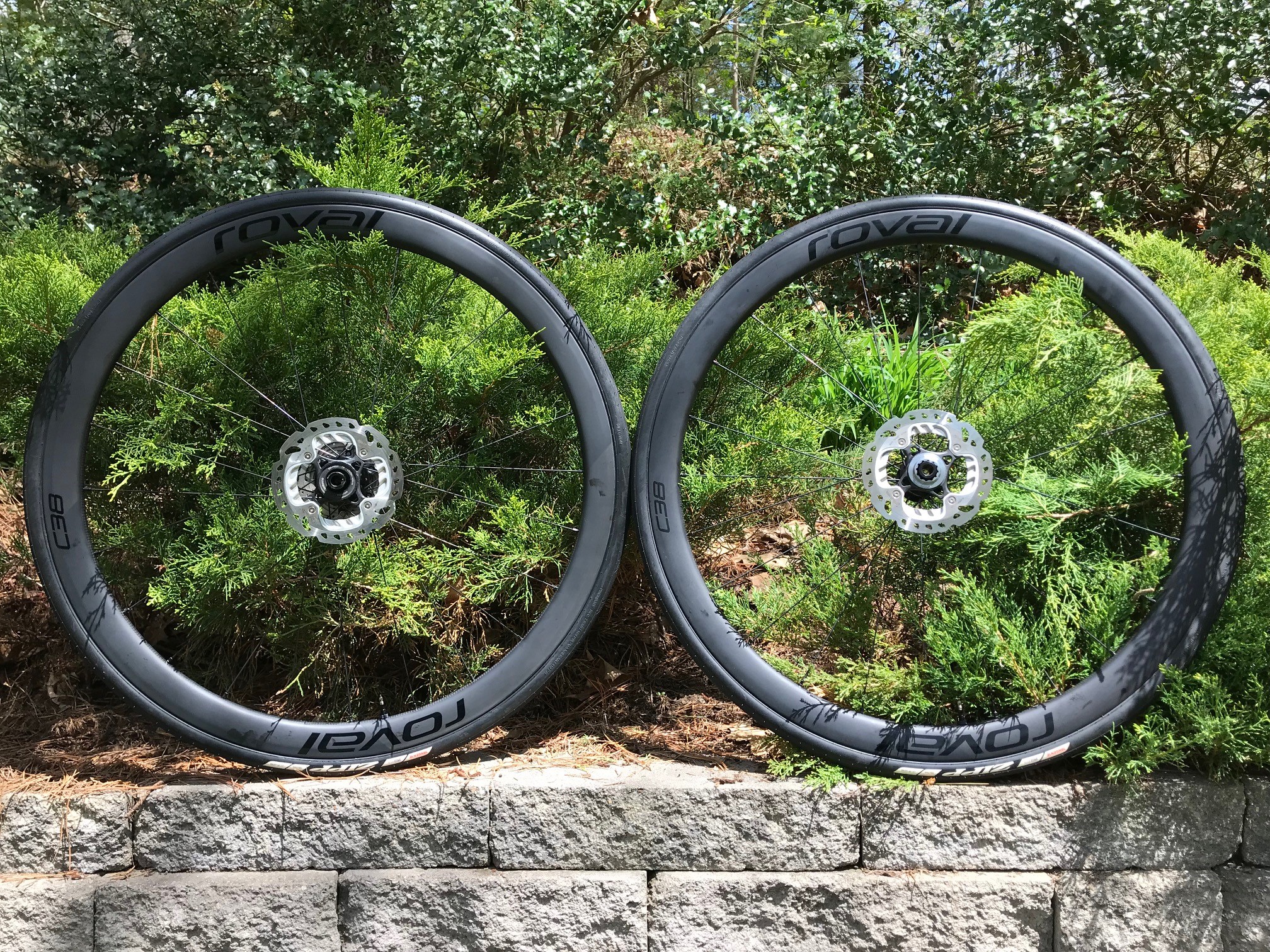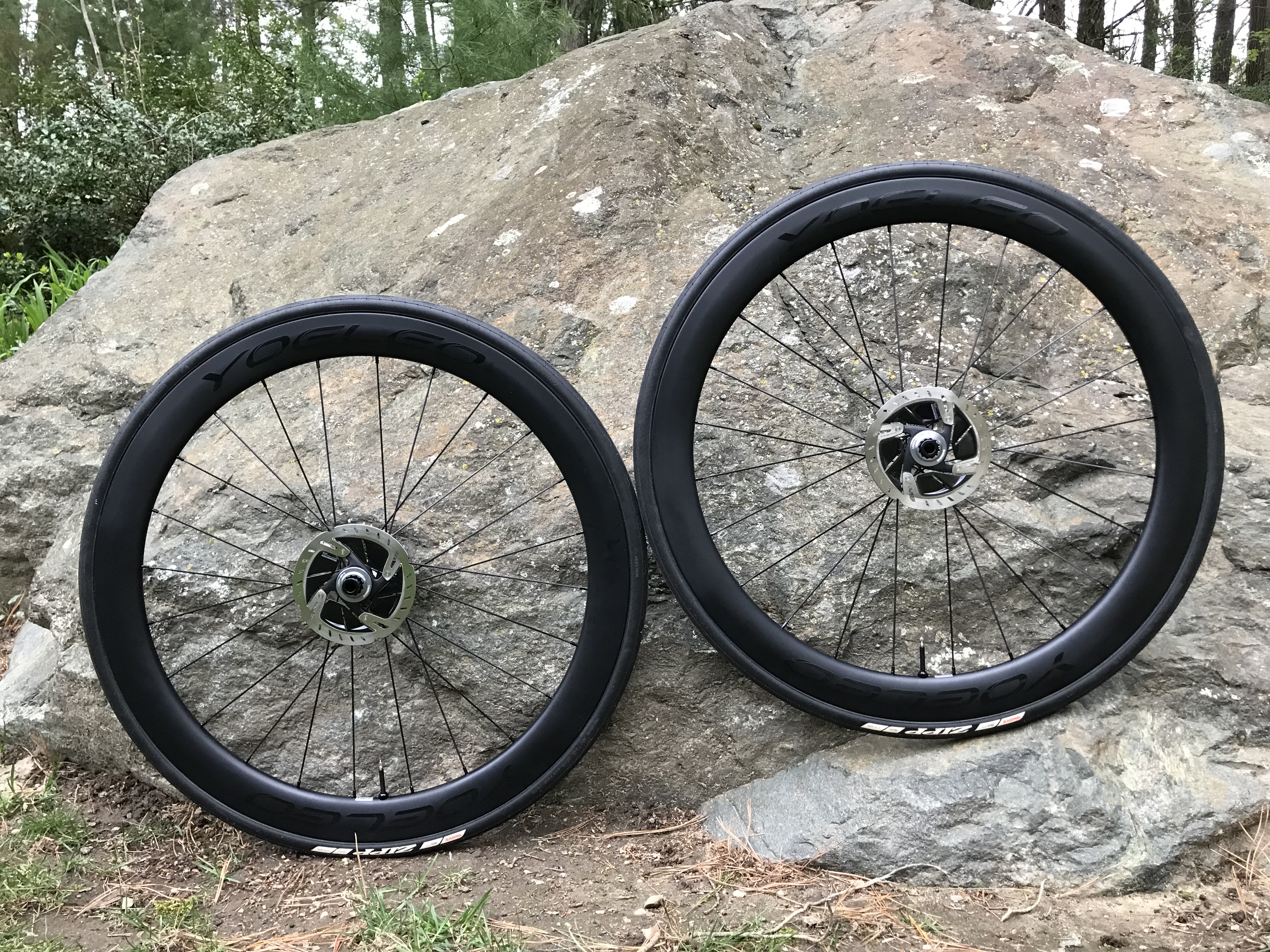
[ad_1]
Summary: Candidates for the best value carbon wheelset that some also call the “best wheelset for the money” sell for between US$900/£900/€900 to US$1500/£1250/€1400. While a few have strengths, none match the range of performance of wheelsets that cost nearly twice as much.
Two have the versatility and responsiveness that should suit budget-minded recreational cyclists looking for a carbon wheelset upgrade for their disc brake road bikes.
The Zipp 303 S is a best value carbon wheelset for cyclists committed to the benefits of riding tubeless, hookless tires. It is available here, here, and here from stores I recommend for their competitive prices and high customer satisfaction ratings.
The Bontrager Pro 37, available here and here, is best for riders that prefer to use tubed clincher tires or ride in windy conditions.
Related Reviews:
THE BEST CARBON ROAD BIKE WHEELS
WHAT YOU NEED TO KNOW
Click on any red statement below to go directly to that part of the post. Click the back arrow to return to this list.
Compare value carbon wheelset prices, ratings, specs, and reviews
Performance differs between value carbon, performance carbon, and alloy upgrade wheels
Companies selling value carbon wheels use different approaches to hit similar price targets
REVIEWS OF VALUE CARBON WHEELSETS
The performance criteria I and my fellow testers use to evaluate wheelsets in the value carbon wheelset category, and others to a greater or lesser degree are versatility, specificity, aero drag (hold momentum), sidewind stability, lateral stiffness, vertical compliance (aka comfort), and responsiveness.
You can read more about what I mean by each of these on my wheelset selection criteria page.
In the search for the best value carbon wheelset, I primarily look for a versatile, all-around type of wheelset that can perform reasonably well on a variety of road surfaces and terrain. While some value-carbon wheels are made for specialists who ride in the mountains or do flat, high-speed courses or ride gravel, specialization is less important in our evaluation of the group of wheelsets in this comparative review.
As I detail after the reviews you see below, even the best value carbon wheelset and wheels in the value carbon category as a whole don’t perform as well as what I call performance carbon wheels that typically cost twice as much.
While durability is also important, we can’t fairly judge it in our testing since we only ride one wheelset of each model. We also don’t ride any wheelset for the year or two we’d need to before writing up the review to really see how well it holds up.
Instead, I look at the return, warranty, and crash replacement policies for each wheelset. These durability policies are especially important since the companies selling value carbon wheels use more varied business approaches and have a wider range of policies than companies selling performance carbon wheels.
Because most road bikes sold for the last several years have disc brakes, the development and, in many cases the sale of rim bike wheels has stopped at many companies. For that reason, I only cover disc brake wheels in this review.
With that background, here are the comparative ratings of value carbon wheelsets followed by our individual wheelset reviews.
Bontrager Aeolus Pro 37 TLR – Best for clincher tire devotees
The Bontrager Aeolus Pro 37 is a wheelset that seems designed for the value carbon road disc rider from the get-go. It is a capable performer in all the key areas I look for in an all-around road disc wheelset and gets my nod as a best value carbon wheelset.
“Capable performer” may read like a backhanded compliment. I don’t intend it to be. It’s just that most of the wheelsets in the value carbon category have one or more major performance weaknesses that limit what you can do with them. This Bontrager doesn’t.
While the Aeolus Pro 37 doesn’t perform at the level of US$,£,€2000 and up carbon road disc wheelsets, its ride gave me equal or better performance across the board compared to other wheelsets I’ve tested within hailing distance of the Aeolus Pro 37’s US$1500, £1250, €1400 price-point.
It accelerates well and climbs without restrictions. It was plenty stiff enough for me doing either of those efforts and when I powered up for some town-line sprints.
Shod with 25C Continental Grand Prix 5000 tubed clincher tires at 70 psi for my roughly 145lbs/66kg weight, I found this Aeolus Pro 37 wheelset’s comfort and handling good – neither outstanding nor lacking.
The DT Swiss 350 rear hub freewheels with nary a whisper, allowing you to enjoy the peace of your ride or the calls from paceline mates. Audible preferences aside, they perform inconspicuously, neither rolling or engaging noticeably better or worse than most hubs in the value carbon price range.
I rode these wheels with standard clincher tires and tubes and I’d recommend you do as well. Bontrager includes a cloth-like strap that simply stretches over the wheel’s sidewalls and snaps into place to cover the rim bed spoke holes.
To go tubeless, Bontrager ships these wheels with plastic strips that add over 100g to the total weight and aren’t easy to install. I snapped one and couldn’t get the other one centered correctly. For US$25, you can get what I found to be quite good Bontrager rim tape to seal the beds for tubeless or tube-type tires, but that takes a little bit of experience to get right.
While I recognize everyone has different tastes and therefore don’t usually share my opinion on the looks of a wheelset, I will say that if you prefer stealthy-looking, matt-finished rims with sufficient badging to let people know what you are riding, these Bontragers will be right up your alley.
Design: As with most bike wheels introduced lately, the Bontrager Aeolus Pro 37 TLR wheelset is only made in a disc brake option and is “tubeless ready”. As per my comments above, I’d recommend you ride it with a tubed-tire setup or tape the rims rather than use the rim strips if you want to ride tubeless tires.
The wheelset with the easy-to-install cloth-like straps for tubed tires weighed 1519 grams on my scale. Taped wheels will weigh much the same depending on the tape you use. With the plastic tubeless strips, the weight increased to 1648 grams.
The rims I rode measured 21.2 mm wide on the inside (between the rim hooks) and 27.8 mm on the outside near where the tire and rim join. With the 25C Continental Grand Prix 5000 tubed tires at my benchmark 100psi, the tires measure 27.6 mm wide. At a more comfortable 80psi, they run 27.4 mm. True to the Pro 37 TLR’s name, the rims measured 37.0 mm deep.
The carbon rim’s profile starts off on the inner spoke edge with a softened V profile and quickly adopts a U shape as it travels toward the outer tire edges. The spokes are bladed DT Swiss Aerolites attached to the rim with external alloy nipples. The hubset is also a DT Swiss branded 350 model.
Quality: While I’ve usually found Bontrager wheels to be very well built, the easy-to-break, hard-to-center tubeless rim strips that I wrote about above were disappointing.
The rim and hub shell finish are first-rate. The decal labels also appear to be well adhered and integrated nicely into the rim design.
Bontrager’s durability policies suggest a high level of confidence in its carbon wheels. You can ride them and still get a full refund within 30 days of your purchase if you decide you don’t want to keep them. They also come with a lifetime materials and workmanship warranty.
The crash replacement policy for these and all their carbon wheels is decent if not the best. They will replace or repair your wheels for free within 2 years of when you bought them if you damage them while riding.
As they are owned by Trek which has one of the largest dealer networks, you can take your Bontrager wheels to any bike shop that sells Trek products for warranty or crash replacement service.
Price: Use these links to order the Bontrager Aeolus Pro 37 for US$1500, £1250, €1400 direct from Bontrager or from Sigma Sports.
For a slightly deeper option better suited for wider tires and maintaining higher speeds on flat and rolling terrain, I suggest you consider the Pro 37’s big brother, the Bontrager Aeolus Pro 51 that sells for the same price from Bontrager or at Sigma Sports.
In The Know Cycling is ad-free, subscription-free, and reader-supported. If you want to help keep it rolling without any added cost to you, buy your gear and kit after clicking the store links on the site. When you do, we may earn an affiliate commission that will help me cover the expenses to create and publish our independent, comprehensive and comparative reviews. Thank you, Steve. Learn more.
Zipp 303 S – Best for tubeless, hookless tire road disc riders
If the Zipp 303 S Tubeless Disc-Brake wheelset I rode for this review didn’t have the Zipp logo on the side of its rims, I wouldn’t have guessed it was from Zipp.
Regardless, it’s clearly a best value carbon wheelset winner.
It has better than average lateral stiffness and average vertical compliance (aka comfort). That’s the opposite of most every Zipp wheelset I’ve ever ridden, and I’ve ridden quite a few in the 202, 303, and 404 series.
The high lateral stiffness is certainly welcome. Over the years, I’ve suggested to many larger or heavier than average readers that they go with a wheelset that is stiffer than those from Zipp. Lateral stiffness also translates to good handling in these wheels and effective climbing for a wheelset of its weight.
Less than Zipp-like comfort in the 303 S isn’t a knock per se and it’s certainly not an issue. These are more like the comfort of the average mid-depth carbon wheelset. I did many 50-mile rides on them without any compliance-induced fatigue. It’s just that I had just gotten used to Zipp wheels being supremely comfortable.
You can certainly make these wheels ride more comfortably by using a 28C tire. But you’ll pay an aero penalty at higher speeds as the tires will be wider than the rims and add unnecessary drag.
Despite their 45mm depth, I felt only a small amount of “free speed” with the narrower 25C Schwalbe tires mounted on the 303 S. The pedaling effort (aka “watts”) I put into creating forward momentum with the 25C and 28C Zipp tires didn’t feel any easier to maintain as it does with more aerodynamic wheel-tire combinations when my speed gets above 20mph.
The 3-pawl Zipp 76/176 hubset is one of the few design aspects or components that carry over from earlier generation Zipp wheels. It’s pretty basic and pleasantly quiet; there’s certainly nothing objectionable about it. But don’t expect to get the same performance and smooth-rolling of the Cognition hub Zipp puts on its NSW wheels just because they have the same logo.
The 303 S wheels did take notice of crosswinds but didn’t trouble me much about them. That was a very good thing as they climbed very well for a wheelset their depth and weight.
Also new for Zipp, the 303 S wheelset along with the new 303 Firecrest is the first in their new gravel wheelset category. While what qualifies as a gravel, road, or cyclocross wheelset or one that’s well suited for all those disciplines these days is debatable, the 303 S internal width helps to make the gravel argument.
From my testing, however, the 303 S rides on gravel more like most 21mm road disc wheels that are only slightly narrower than this one’s actual 22.5 mm internal width (per my measurement) and not nearly as well as the 25C rim width 303 Firecrest and others I’ve found are best for 35-40mm wide gravel tires.
Many ride 21mm (and 19mm and even 17mm) road wheels on gravel these days and you can certainly ride these as I did for many miles on various types of dirt and gravel terrain. But, these and 21C wheels lack the comfort and handling of the best gravel wheels.
Because it’s a Zipp wheelset, I’ve reviewed it as critically as I would any wheelset that sells at historically Zipp-like prices. But this Zipp wheelset sells for far less and should be compared to those from other brands in this review of value carbon wheels that sell in the same price range.
Given its combination of stiffness, handling, climbing, and acceleration performance that are better than most others in this category along with Zipp’s broad dealer service network and lifetime warranty, this Zipp 303 S is a value carbon wheelset “best” pick for those who are committed to getting the lower rolling resistance of tubeless tires and know that they don’t gain anything by using hooked rims.
Design: As mentioned, the Zipp 303 S tubeless disc brake wheels have hookless rims that require you use tubeless tires. Most of the better tubeless tires are hookless compatible and even 200lb/90kg riders needn’t inflate 28mm tires above the recommended 72.5 psi/5 bar maximum inflation pressure.
While most tubeless wheels these days have hooked rims that will lock in the flexible beads of tube-type clincher tires and give you the option to choose between going tubeless or tubed, you can only use tubeless tires on these wheels. If you prefer to use clinchers, these wheels aren’t for you.
The wheels weighed 1556 on my scale with pre-installed rim tape but no tubeless valves. They measured 45.2mm deep with a 22.5mm inside and 27.5mm outside rim width. The rim profile starts V-shaped at the spoke bed and quickly transitions to more of a parallel U shape.
Zipp uses their 3-pawl 76/176 hubset on the 303 S, one they used previously on the first 302 and earlier 303 Firecrest disc brake wheels. There are 24 bladed, j-bend spokes on the front and back wheels with external nipples.
The rims are made and the wheels are assembled in SRAM’s Taiwan factory.
Quality: Like many lower-priced wheelsets, the hubs use push-in end-caps. That’s usually not a problem but if you frequently remove the 303 wheels from your bike and change between road and gravel tires, it’s not difficult for the end-cap on the freehub to pull off from the weight of the cassette. It happened to me on a couple of changeovers and I had to scramble to put a pawl or two back in place. I was more careful after that.
Most notably, Zipp now gives the original owner of their wheels a lifetime warranty on any materials or workmanship defects. If it fails while riding or racing a wheelset in the way it was intended, they will repair or replace it at no cost to you for the lifetime of your ownership. That’s about as good as it gets.
Zipp doesn’t offer a trial riding period as some other brands do. They leave that up to their individual dealers to determine whether to credit or refund you if you want to return one of their wheelsets after riding it.
Like other major wheelset brands, Zipp has an extensive dealer network of bike shops you can bring your wheels into for any repair or warranty issues regardless of where you purchased them.
Price: The 303 S wheelset lists for US$1400, £1090, €1320, a very un-Zipp-like price. It often sells for less if you live outside North America.
You can order the 303 S at stores I recommend for their competitive prices, great selection, and high customer satisfaction ratings using these links to Competitive Cyclist, Planet Cyclery for North American residents, and Sigma Sports, Tredz (10% off for In The Know Cycling readers with code ITKTDZ10), Bike-Components for those in Europe.
Scribe Aero Wide+ 50-D – Loud, aero, and unexpected
If you really don’t like the sound of a really loud freehub when coasting, the Scribe Aero Wide+ 50-D wheelset really isn’t for you.
I’m not talking about what you hear coming out of the latest generation DT Swiss 240 freehub or the louder yet distinctive chordal sound of a Chris King R45 freehub. No, the Scribe freehub is a far louder, lower-pitch noise that almost sounds angry.
Other riders told me not to coast near them, based on their hand motions because I couldn’t hear them, at least until I started pedaling again. My fellow tester Miles heard the comments too from those in his group when free coasting down fast downhill.
And yes, I tried to quiet the hub using the grease and video instructions Scribe sent me for that purpose. I noticed little difference.
I go into this first because it’s the most distinctive characteristic of this wheelset.
If none of that bothers you, or you prefer loud freehubs as I know some do, the Scribe Aero Wide+ 50-D is a great value-priced, carbon wheelset option for fast riding and racing on flat and modestly rolling terrain.
Miles and I found these Scribe wheels hold their momentum well at speed on straight sections. They are also plenty stiff enough to give you the confidence to lean into a corner, ride through it, and power out at high speeds.
If you’ve got the watts of a racer like Miles, these Scribes are responsive and fast enough to cover most any accelerations. For me, more of a B group rider without the turbo boost power of a racer like Miles, their response felt more like a slower reacting, more typical aero wheelset.
When the road pitches up, both of us found the wheels struggled, as do many aero wheelsets. Rolling courses with long yet modest hills make you work hard on the Scribe Aero. Short kickers of 7-10% really slow you down.
For me, the aero wheelset analogy extends to my need to also lean these Scribes into steady sidewinds to stay on my line. When I got hit by gusts, I couldn’t hold it.
Miles had a better experience, finding the sidewinds didn’t affect him much, and performed better than others he’s tested. While we weigh more or less the same, the winds were highly variable during our spring testing perhaps leading to our different reactions.
With a good set of supple, tubeless tires inflated lower than you might normally set them, the Scribes can be quite a comfortable wheelset on good roads and bad. We tested them with both 28mm Schwalbe Pro One TLE and 28mm Continental Grand Prix 5000 S TR tires at pressures ranging from 55psi/3.8bar to 65psi/4.5bar for our 148lb/67kg to 155lb/70kg body weight.
The Contis at the lowest inflation pressure was the most comfortable combination.
Design: I measure and weigh wheels when they first arrive, share none of that info with my fellow testers, and forget most of it myself with all the gear traffic coming through my door. That usually turns out for the best as not knowing the specs limits the performance bias we might bring into our test riding.
That certainly made sense for this wheelset. The specs and most of the “Aero Wide+ 50-D” name suggest very little about how we found that these wheels perform.
At 1529 grams measured with pre-installed tape but without the valves (vs. the claimed 1448 grams) and 50.5 mm depth, they spec out more like an all-around wheelset than an aero one.
Measuring 29.6mm externally near the tire edge of the rim, 30.2mm at their widest point, and 21.1mm internally, these wheels are wider than some but not nearly as wide as many that provide the kind of handling and comfort these Scribes can.
So the Wide+ and 50 in their name might suggest a different type of performer than what we found. If they drop those parts of the name and simply call it the Scribe Aero D, they’d have a name that better describes this wheelset’s performance. (This probably wouldn’t work with the rest of their product names, however, as all of their carbon disc brake wheels are called Aero Wide+ followed by the rim depth number ranging from 32mm to 80mm).
And despite all the attention the loud freehub with its glossy hub shell and white script Scribe logo calls to this wheelset, the matt grey finish on the rims we tested is quite a modest look. Miles calls them “boring.” They look ok to my style-blind eyes but certainly are at odds with the boisterous, flashy hubs.
While I’m really out of my depth trying to psychoanalyze a set of wheels, the unexpected nature of the Scribe’s performance compared to its specs and its aural and visual aesthetics seem to make it, behaviourally if not technically, an eccentric wheelset. The freehub almost calls out at you, saying “look at me.” When you do, the rim finish seems to respond with “there’s nothing to see here.”
Setting aside my psychobabble (or should I say cyclobabble?), this Scribe is another example of why I focus on performance and not specs in our reviews.
Quality: Scribe’s warranty policies are better than many that sell wheels at similar price points especially those sold direct by overseas manufacturers.
Specifically, they offer a 3-year warranty against material or workmanship defects and a 50% crash replacement discount for the life of the wheels. Should you need or want them, they will also send you a set of replacement bearings in years 2 and 3 of your warranty free of charge. All of these apply to the original owner.
Miles and I didn’t experience any quality issues during our several-month test period. I did open up the freehub to grease it and to my untrained eyes, it seemed to be well-built. Scribe includes valves and lockrings along with spare spokes, nipples, and other parts to adapt the wheels to older disc brake rotor technologies.
Price: Available direct from Scribe, the Aero Wide+ 50-D wheelset sells for US$1100, £870, €1100. While shipping is free, Scribe notes the price “may be subject to additional customs charges” and indeed mine were though Scribe told me that it doesn’t happen often.
Hunt 50 Carbon Aero Disc – Buzz Overwhelms Performance
Performance: Hunt generates a great deal of buzz for its products and brand, seemingly as much as or more than some wheelset sellers many times Hunt’s size and experience. I bought these wheels looking to experience how they actually performed, separate from the buzz.
It turns out that you can’t separate the buzz from the performance. Unfortunately, it’s the freehub buzz rather than the marketing buzz that is inseparable from these wheels.
Simply stated, the freehub sound on the Hunt 50 Carbon Aero Disc is one of the loudest fellow tester Miles and I have ever heard from wheels we’ve tested or ridden alongside. Far louder than a Chris King or i9 that are known for their distinct and loud freehubs but nowhere near the refined fuller frequency sound from the multiple points of engagement those hubs offer.
The freehub is so loud that you can’t have a conversation with a friend while coasting on these wheels. I tried it. Could hardly hear a thing he (or I) was saying.
Miles, a fan of distinct sounding freehubs, wrote in his test report: “It was not quite a chainsaw, but it was close.” With tongue firmly planted in cheek, he added: “It was cool and will turn some heads, but I could have used a slightly quieter freewheel sound.”
My more practical concerns – 1) being able to communicate with fellow riders in a paceline and 2) wrecking the peace I so enjoy (and deserve) going downhill after a hard climb.
Aside from the freehub, the Hunt 50 Carbon Aero Disc performance is a prime example of what separates most value carbon wheelsets from higher-priced performance carbon ones.
Unfortunately, it’s not just the price. Rather, this wheelset lacks the comfort, stiffness, climbing, and handling qualities of performance carbon wheels. It also underperforms other value carbon wheels that have a strength in one or two areas that might align well with what you are looking for and cause you to overlook other weaknesses because you’re getting the wheels at a lower price.
Though it was not outstanding, the 50 Carbon Aero Disc wheelset’s aero performance was probably its strongest characteristic. They feel more like a 40mm deep wheelset with some sense that your momentum is being sustained but not to the level of a similar depth value carbon wheelset like the Scribe Aero Wide+ 50-D.
You also feel a little bit of push from crosswinds, though nothing to move you dramatically off your line.
For those of you that enjoy sprinting hard out of the saddle, Miles found these Hunt’s responded well and shot forward with purpose. Going uphill, however, they felt quite average to both of us and offered no help from their lateral stiffness or aerodynamics.
Design: The Hunt 50 Carbon Aero Disc rims measured 50.1 mm deep with 19.5mm internal and 26.5 mm external widths. Since I reviewed this wheelset, Hunt started sellin an SL version of this wheelset with the same depth and external width but 21mm internal width that weighs 60 grams less but costs about US$300 more.
The rims have more of a V than U-shaped profile. Using 25mm Zipp Tangente Speed tubeless tires (since discontinued), they measured about 0.5mm narrower than the rims at 80psi.
Hunt uses bladed and butted Pillar spokes on these wheels, 20 in the front and 24 in the back. The hubs are Hunt branded Race Season Disc straight-pull with 7.5 degrees of engagement. Novatec has made hubs for Hunt in the past but I was unable to determine whether they make the ones on this wheelset.
With rim strips but no valves, the wheels weighed 1579 grams on my scale or about 90 grams more than the 1487 gram weight Hunt claims for this wheelset.
Quality: The wheels themselves appeared well made and had a very even matt black finish. They came with extra spokes and other spares in case you ever need to replace them.
The quality of Hunt’s service, while very polite and well-intentioned, gave me every indication that the company lacks established processes and financial controls in important customer service areas.
The set I ordered came damaged with the freehub having come through the side of the box. It happens and was likely caused by the shipper or a customs handler rather than Hunt. The replacement set was shipped from the next monthly allotment unscathed and well packaged. Hunt initially charged my account to ship the damaged wheels back but refunded me after several requests.
Because I didn’t care for the wheelset’s performance, I decided to return them under Hunt’s 60-day tryout policy. It took me over 20 emails and several more exchanges with their online chat over a month’s time to get the wheels back and refunded.
Getting Hunt to respond to the return request, securing the shipping labels, scheduling the shipper, acknowledging the return, and then processing the refund each took at least 3 e-mail requests from my end for every one of these steps. (The refund process took many more than 3.)
There were 6 or 7 Hunt advisors that responded over that time with, at times, incomplete, incorrect, or contrary information, occasionally with multiple responses from different advisors and email domains to the same email from me.
Price: When I bought these wheels, they sold for US$1079. At last check, they sell for USD$809, £899, €889 including shipping. They are available directly from Hunt’s online store.
Light Bicycle AR465 – Average Performance Across the Board
(Note: Light Bicycle now calls the WR46C02 wheelset I tested for this review the AR465. Per their representative, nothing other than the name and decals have changed. I have updated the name in this review.)
While the performance of these all-around disc brake wheels is a long way from US$,£,€2000 and up performance carbon models, the Light Bicycle AR465 wheelset with DT Swiss 240 hubs offer the most average performance of any in the value carbon wheelset category.
That’s a qualified statement so let me break the performance down to its components and comparisons.
First, it’s not on par with stiffness, comfort, responsiveness, handling, or any of the other key performance criteria of the performance carbon all-around carbon disc brake wheelsets I’ve reviewed. But, none of the wheelsets in this category are.
Yet, while some of the wheels in this category offer performance strengths (e.g. stiffness) relative to other value carbon wheelsets only to be offset by comparable weaknesses (e.g. comfort), these Light Bicycle wheels impressed me and fellow tester Miles for doing most everything on our performance lists decently, or at least no better or worse than the average.
While not as stiff as say, the Bontrager Aeolus Pro 51 TLR Disc wheelset or as aero as the Scribe Aero Wid+ 50-D, these AR465 wheels are both adequately stiff and do help hold your momentum somewhat. Though not climbing wheels, they also go uphill reasonably well and certainly better than some of the heavyset hoops in this review.
While I have found few of these value carbon wheelsets to be in the same comfort ballpark as the performance carbon ones, the AR465 wheels were comfortable enough to run tubeless at the low end of my air pressure range and not wear me out when I did a 4-hour ride on them.
The handling was decent, the DT Swiss 240 hubs I speced the wheels with are relatively quiet and roll smoothly, and the rims managed the crosswinds predictably despite being an older V-shaped profile. Set up with 25mm Zipp Tangente Speed tires, they measured about 1 mm narrower than the outside rim width. That’s good for aero performance.
In a flat-out sprint, while not floppy, they did not feel super fast in a straight line. Instead, they seemed rather average among similarly priced wheels.
It’s also worth noting that their subtle finish is attractive and the tires went on easily, sealed with only a track pump, and held air and sealant well.
Design: This wheelset tested weighed in at 1504 grams without rim strips or valve stems. Light Bicycle claims the rims weigh 435 grams though I was unable to verify that. They measured 21.3mm wide between the bead hooks and 28.3mm outside.
The rims have a classic V-shape profile and use 28 CX-Ray J-bend spokes in the rear wheel, 24 in the front, both connected to external alloy nipples and the DT Swiss 240 hubs. You can have the wheels built with a list of more or less expensive hubs and spokes and choose either thru axles end caps or quick release skewers to fit your bike.
Quality: The wheels looked well built and stayed true during our testing. While Light Bicycle offers a 5-year warranty, it only covers the rims. Further, the company only covers the shipping costs to return the wheels to the office in Canada or China for the first 30 days of the warranty.
If you have issues with the hubs or spokes, you need to go to the manufacturers of those parts to deal with those issues. Hub warranty terms are usually a year. There are no warranties on spokes. You’d also have to pay for the wheels to be rebuilt at a local bike shop.
Light Bicycle doesn’t warranty the workmanship surrounding the assembly of the wheels’ components. When I asked about that, they offered to write a one-year warranty on the invoice but claimed they have never had the need to provide this type of warranty.
If you crash the wheels while riding, you’ll only be offered a 10% discount to replace them. Don’t like the wheel build or something else about the wheels? You’ve got 30 days to return them unused and will pay a 5% restocking fee before you get your refund.
Frankly, these policies alone make me uncomfortable buying wheels from Light Bicycle no matter how they perform.
Price: With the DT240 hubs and Sapim CX Ray spokes I spec on the wheels I tested, the AR465 wheelset runs US$1158 if you live in North America, not including shipping. They are assembled in Canada and duties and taxes are already built into the price.
If you live outside North America, the wheels are shipped from China. While they are priced a couple of percent less than the North American price, shipping, duties, and taxes to your location will likely make them more expensive and take longer to be delivered.
You can purchase them directly on the Light Bicycle website.
Join KNOW’S CLUB – GET
MORE VALUE FROM IN THE KNOW CYCLING
BREAKAWAY membership – Be the first to see reviews
- Get 7-day advance notice of newly published and updated reviews
- US$29/year
PACESETTER membership – Help choose what we review
- Nominate and vote on wheelsets and other gear for review 4x/year
- Includes all BREAKAWAY member benefits
- US$59/year
LEADER membership – Get personalized product recommendations
- Get Steve’s recommendation on wheelsets and gear for your situation
- Includes all PACESETTER AND BREAKAWAY member benefits
- US$199/year
Bontrager Aeolus Pro 51 TLR – Quiet, comfortable, but lackluster
I had high hopes going into our testing of the USD$1500, £1250, €1400 Bontrager Aeolus Pro 51 TLR wheelset. We rated its shallower and similarly priced sibling, the Aeolus Pro 37 one of the best value carbon wheelsets for its capable range of performance. And our review of the Aeolus Pro 51’s more expensive twin, the Aeolus RSL 51 that shares the same rim profile carried the headline: The Definition of an All-Around Road Disc Wheelset.
I and probably many of you keep on the lookout for that value-priced wheelset that rides nearly as well as one that costs twice as much. Using a set of performance criteria (not specs) to evaluate wheels, my fellow testers and I have ridden over a dozen value carbon road bike wheels (and another half dozen gravel ones) over the last few years in search of one that would save you a bucket full of money without giving up more than a shot glass worth of performance.
Unfortunately, the Bontrager Aeolus Pro 51 isn’t it.
Like all but a few wheelsets in this price range, the Pro 51 performs adequately in some areas and less so in others. From the rides that fellow tester Nate and I did, however, the Pro 51 doesn’t match or approach the overall performance we enjoyed of its RSL 51 sibling or the balance of good performance across areas like its shallower Pro 37 kin does.
Comfort is the Aeolus Pro 51’s biggest strength. Its wide rim profile allows you to run 28mm tires without sacrificing aero performance while keeping the pressure low enough to soak up the bumps on paved, poorly paved, or unpaved roads quite nicely.
True, the right tire and pressure are a big part of enjoying a comfortable ride these days. But I’ve ridden enough wheelsets, especially in the value carbon price range where the rim/spoke/hub component choices, lacing, or assembly dodn’t enable enough vertical compliance in the wheels for a comfortable ride regardless of the tires and range of pressures I tried.
The Pro 51 felt planted in corners though accelerating out of them was underwhelming. They’re stiff enough to confidently get you through but not responsive enough to get you flying out.
That lack of responsiveness also showed up during acceleration efforts. They were not at all lively. It took a lot of effort to get them up to speed.
Once up to speed, it took more effort to keep them there compared to the best wheels at this price point and more expensive ones. That was disappointing since the Pro 51 uses the same rim shape as the RSL 51.
While aero performance, which we judge based on our ability to maintain momentum in the 20-25mph/32-40kph range for the RSL 51 was good but not exceptional compared to top-performing all-arounds, the Pro 51 isn’t on par with the RSL 51.
The common rim profile gene did show up in the Pro 51’s good stability in side winds. That’s a welcome benefit if you ride where it is regularly windy.
Climbing with the Pro 51 was a drag, figuratively and literally. Even riding a course with rolling hills took more effort than a wheelset this depth should. 7% grade climbs put me in the hurt locker the way 10%+ ones normally do.
All of this made me feel like I had “dead legs” when riding the Pro 51. I do get those days regardless of the wheelset and certainly feel that way when trying to climb or ride aggressively on most 60mm deep wheels rather than the straight flats they are designed for. But, I should feel better than that on a good set of all-around wheels of the Pro 51’s depth and profile.
Nate put a finer point on it, saying the Pro 51 wheelset’s responsiveness was “dull.”
Design: The Aeolus Pro 51 measured 1625 gram weight likely contributes to its relative lack of responsiveness, acceleration, and climbing ability. That measurement is with about 15 grams of tubeless rim tape and no valve stems. If you instead install the 60-gram per wheel plastic tubeless strips that Bontrager includes in the box, well we’re getting into stock wheel weight territory.
Even with the TLR rim tape, the Pro 51 is almost 200 grams more than the RSL 51 (1441 grams measured) and even 50-100 grams more than my top-rated aero wheels that are 10mm deeper and, well, more aero.
I don’t know how much of that extra weight is in the rims where it matters most vs. in the hubset. Bontrager uses the DT Swiss 350 hubs in their Pro line of wheels which, while heavier than the DT Swiss 240 EXP, are infinitely quieter. Quieter as in absolutely silent.
While there may be a performance difference between the 240 and 350, I can’t feel it on the road. But I sure do notice the solitude of a quiet freehub.
As mentioned, the Pro 51 rims are wide measuring 23.2mm inside and 31.0mm outside with an actual depth of 51.5mm.
Quality: The matte-black rim finish on the set I tested didn’t clean up very well. No matter what I tried, the finish looked quite blotchy. While you don’t buy matte-black rims for their finish and the blotchy look is only visible when you look closely in the right light, it’s disappointing nonetheless.
Bontrager’s durability policies should cover this issue. You can ride (and clean) the wheels and still get a full refund within 30 days of your purchase if you decide you don’t want to keep them. They also come with a lifetime materials and workmanship warranty.
The crash replacement policy for these and all Bontrager’s carbon wheels is decent if not the best. They will replace or repair your wheels for free within 2 years of when you bought them if you damage them while riding.
As they are owned by Trek which has one of the largest dealer networks, you can take your Bontrager wheels to any bike shop that sells Trek products for warranty or crash replacement service.
Price: You can use these links to order the Bontrager Aeolus Pro 51 TLR wheels direct for USD$1500, £1250, €1400 from Bontrager or at Sigma Sports.
Roval Rapide C 38 Disc – Stiff, uncomfortable, and twitchy
The Roval Rapide C 38 disc is made only for disc brake bikes but marketed for use on both paved and gravel surfaces. I only rode these wheels on paved roads, albeit some that were similar to a well-maintained dirt one.
For Roval’s sake, I hope the C 38 does better on gravel surfaces than what I experienced on paved roads.
Despite its modern 21C/21mm internal rim width, I couldn’t find a tire pressure at which it rode comfortably. On smooth paved roads at 60 psi where I normally ride 25mm tubeless tires on rims the width of these (26.9mm outside width), my 150lb body found the C 38’s comfort no more than acceptable.
On chip-seal roads where I test rode the wheels with tire pressures from 55 psi up to 75 psi, it was harsh to the point where I was backing off my speed to reduce the vibration.
Why not use 28mm or wider tires to improve comfort? If you prioritize comfort, you should.
But I was trying to test Roval’s claim that the C 38 “outperforms many deeper, aero-specific rims that cost twice as much.” Setting up the C 38 wheels with 28mm tires would make the tires wider than the rims, going against a basic guideline of wheelset aerodynamics.
Even with the 25mm tires on these Rovals that made the rims marginally wider than the inflated tires, I had to work harder to maintain my speed than with deeper value carbon wheelsets (and performance carbon ones “that cost twice as much”) while doing intervals in the 20 and 25mph range.
And while I shouldn’t expect a 38mm deep wheelset would be more aero than a 50mm deep one, this confirmed that Specialized’s C 38 version of a 38mm deep wheelset isn’t an exception.
The C 38 also got pushed around by steady 10 mph crosswinds. While it was disappointing that a relatively shallow value carbon wheelset would be so easily affected in these modest breezes, I was even more surprised at how twitchy and hard to control the wheelset was going downhill at 30mph in these crosswinds.
I did find the C 38 quite stiff and handled very well when on good paved surfaces. While there was no snap when I accelerated, they did respond on par with the deeper 45mm and 50mm value carbon wheels I’ve been testing, most of which are also not rubber burners.
There’s no denying the C 38 comes at a good price from a company whose dealer network through parent Specialized offers great service and support. Despite all that goodness, its better-than-most stiffness, and confident handling performance, these wheels weren’t fun to ride and held me back from going as hard as I normally like to.
At the end of the day, that’s what matters most to me.
Design: I measured the wheelset I tested at 1608 grams including the rim strips but not valves. The rims measured 38.0 mm deep, 21.3mm inside, and 26.9 mm outside on the U-shaped rim.
DT Swiss has been known to make complete stock wheels under the Roval brand name for parent Specialized’s bikes and may be making the C 38 as well. The wheels come with round DT Competition Race spokes, 24 both front and back attached by brass nipples, and use a DT 370, 18 tooth hubset.
Quality: Roval provides a lifetime material and workmanship warranty to the original owner. If you buy the wheels from the original owner, Roval will still stand by them for 2 years from the original purchase. This is unique. I’ve not seen many “second owner” warranties offered by other wheelset sellers.
The 2-yr free repair or replacement crash replacement policy covers the original owner if the wheel is damaged while riding.
Price: The Roval Rapide C 38 lists for US$1100, £999, €1245, and is available at these links to recommended stores Competitive Cyclist and Sigma Sports.
Yoeleo SAT C50|50 DB PRO – Laterally compliant, vertically stiff
While most roadies like a laterally stiff wheelset that transfers power efficiently to the road that is also vertically compliant to help cushion imperfectly paved roads, I found the Yoeleo SAT C50|50 DB PRO underperformed the better value carbon wheelsets on both measures.
As a lighter and therefore less powerful rider, I’ll typically have to work hard climbing and sprinting to notice stiffness differences. With this Yoeleo wheelset, I noticed them right away. Compared to nearly every other value carbon wheelset I’ve tested, the SAT C50 felt imprecise pedaling up the first modest hill I hit within a mile of my house.
When I increased the tire pressure 10 psi, they rode a bit stiffer though they still weren’t stiff. And lowering the pressure the same amount didn’t really improve the comfort.
The handling did improve at higher pressure but that’s more likely due to the tires than the wheels.
After many rides at different pressures and considering the tradeoffs, I ended up riding them about 5 psi higher than I normally ride. This seemed to get me the best performance balance between stiffness, comfort, and handling for these wheels. Unfortunately, the Yoeleos still underperformed on all three of these criteria.
Strangely, however, the balanced underperformance seemed easier to get used to over time than wheelsets that were good performers on one of these criteria, say stiffness, and subpar performers in others, for example, comfort.
While 50mm deep and with the good DT Swiss 240 hubset I specified for these test wheels, the SAT C50 didn’t feel particularly fast or helpful in maintaining aero speeds. While weighing only 1459 grams, quite light for any road disc wheelset of this depth, they didn’t climb or accelerate markedly better than the heavier, stiffer value carbon wheels I tested for this comparative review.
Design: The Yoeleo SAT 50|50 DB PRO would seem to have all the specs to make it one of the better-performing wheelset. My conclusion that it is a below-par performer further proves that you can’t go on specs in predicting how well a wheelset will ride out on the road.
My 50.2mm deep test wheels weighed 1459 grams which compares favorably to the claimed weight of 1518g. Unlike many lower-priced carbon wheels that use Toray T700 standard modulus fiber, Yoeleo uses the higher modulus, higher tensile strength Toray T800 intermediate modulus carbon fiber for these wheels. With all else being equal (rim wall thickness, spoke bracing angles, hub flange diameter, etc.), this should give the wheels a higher strength-to-weight ratio and make them stiffer than what I experienced. Clearly, something wasn’t equal.
The rims have a classic toroid profile even more pronounced than the original Zipp 303 which was one of the originators of this shape. These Yoeleo wheels measure 26.0mm wide at the brake track and 27.7 mm at their widest point. The internal rim width between the bead hooks is a healthy 18.5mm, narrower than the 21mm inside width you find in most of today’s value carbon wheels.
You can also order the wheels with a 25mm outside width (unspecified inside width), though I don’t know why you would.
While the wheelset I specified for this review had DT Swiss 240 hubs with Sapim CX-Ray spokes, the latest model SAT C50|50 DB comes with Pillar Wing 20 spokes and the option to specify Yoeleo brand 230 hubs for $400 less. You’ll also find Pillar spokes on wheels made for brands including Scribe and Hunt. I have no experience with Yoeleo brand hubs.
Quality: Yoeleo’s durability policies are quite limited. They offer a 3-year warranty against defects but only cover the shipping costs for the first 3 months should there be a problem. And you’d need to ship the wheelset to China.
If you decide you don’t want the wheels after they first arrive, you have just 3 days to inform Yoeleo that you want to return them, and here again, you pay for shipping. They offer no crash replacement policy.
My test wheels arrived true and looked well built. While I rode them for less than 1,000 miles, I encountered no quality issues with them during that time.
Price: Currently, the SAT C50|50 DB sells for US$1300 with DT Swiss 240 hubs. You can buy them directly from Yoeleo.
PERFORMANCE DIFFERS BY WHEELSET TYPE
I’ve heard some riders and marketers say that a set of US$1000-1500 carbon wheels, what I call a value carbon wheelset, get you 80%-90% of the performance of the best or performance carbon wheels at 1/2 to 1/3 of the price.
While it’s a memorable line, it lacks the context to make it useful, let alone accurate.
It’s really hard to make any overarching statement like that without knowing, for example:
- Which value carbon wheels and which performance carbon wheels are you comparing?
- Which performance characteristics are you considering?
- Which characteristics are most important to you in making a wheelset decision?
As you likely know and can see on the home page, I and my fellow In The Know Cycling testers write reviews that compare a half-dozen or more wheelsets intended for a similar purpose and put them into a single post for you.
For example, which are the best climbing or all-around or aero wheelsets? Which are the best rim brake upgrade or gravel bike wheels? And how do you choose between those categories to find the best for you?
While there are performance characteristics that are unique to each category or more important when comparing wheels in some categories versus others, there are a handful of characteristics that are important across all categories.
Most of the value carbon wheels I am reviewing in this review in my search for “the best wheelset for the money” are all-around category wheels. This category includes mid-depth (40-50mm) wheelsets that are intended to be used for training and road racing, on the flats and in the climbs, mostly on the road but also for a modest amount of cross or dirt riding off of it as well.
As the “all-around” description suggests, these wheels should be good in most situations if not ideally suited for one specific terrain (e.g. climbing), event (e.g. time trials), or surface (e.g. smooth, paved roads).
The performance criteria I and my fellow testers use in search of the best value carbon wheelset and the best in most other categories to a greater or lesser degree are versatility, specificity, aero drag, sidewind stability, lateral stiffness, vertical compliance (aka comfort), and responsiveness.
You can read more about what I mean by each of these on my wheelset selection criteria page.
In this section, I’ve compared some of the better and average value carbon wheels against some of the better and average performance carbon wheels that cost much more and alloy upgrade wheels that usually cost less.
This is a fool’s errand but I’m a fool and am trying to provide you a general reference point of what to expect for a specific performance characteristic between wheelsets we’ve tested representative of these three different groups. This will hopefully be better than the horribly inexact and simplistic “x% of the performance at y% of the price” that some people lean on.
I’ve no doubt that I will get comments from some of you saying your $500 alloy wheelset is good enough for you to perform just as well or better than those you ride with or race against who use a $3000 carbon wheelset. I won’t try to confirm or explain why your experience or evaluation differs from mine other than to say there might be some other things to consider beyond just the wheels in such a comparison.
My fellow testers and I have ridden, compared, and reviewed many, many wheelsets. You can read and compare my take on whatever wheelsets you are interested in by entering the wheelset name in the “Find a review…” box at the top of the page.
Rather, what follows is a distillation of our experience.
Versatility
 (Comparative Performance Key: + Better, 0 Average, – Worse)
(Comparative Performance Key: + Better, 0 Average, – Worse)
The most desirable all-around wheels will give you the versatility to ride, without making major performance compromises, on different types of terrain (hills, flats, false flats, straights, corners, sprints, mountains, fast downhills, windy roads, paved and unpaved) that you’ll experience and a range of training and events (club races, centuries, club, charity, group rides) you’ll want to do.
Performance carbon wheelsets clearly have an advantage here. The better and many of the average wheelsets are more aero, responsive and comfortable, and climb better than value carbon or alloy upgrade wheels we’ve ridden. That makes them more versatile for the range of terrain you might ride, events you might do, and surfaces you might traverse, especially if you are comparing the more modern disc brake wheelsets.
The better and average value carbon wheels I’ve tested are somewhat more versatile than the better and average alloy upgrade wheels. Being deeper and with good hubs, they are better at holding aero speeds above 20mph/32kph. In quite a few cases, however, that comes with crosswind management issues that you don’t experience with the shallow alloy upgrade wheels (or the more advanced rim profile designs of the performance carbon all-around depth wheels).
While most of the value carbon wheels are wider than most of the alloy upgrade wheels, I haven’t found the former group to be any more comfortable. This limits your desire to want to ride them off-road (and in some cases on them).
To fill out the versatility consideration, I think about how much I’d like to climb with these wheels. The value carbon wheels are generally a bit heavier than the performance carbon ones. Others are not as stiff. I haven’t found any that are as light and stiff as the better and average performance carbon wheelsets.
Alloy upgrade wheelsets, though shallower than value carbon ones, aren’t noticeably lighter and often not as stiff. This limits their versatility.
Specificity
(Comparative Performance Key: + Better, 0 Average, – Worse)
With less engineering put into value carbon wheels than performance carbon ones and almost none going toward alloy-upgrade ones anymore, it’s unlikely that you’ll find terrain, surface, or discipline-specific wheelsets that perform at the same level as performance carbon ones outside of those from that category.
Value carbon wheels often have some combination of older rim profiles, lower-spec carbon layups, or less advanced hubs. From a performance sense, this makes them less aero for flats and speed disciplines and heavier for climbing and many road racing ones than performance carbon wheels. They’ll also usually not have as wide to enhance comfort or as stable in side winds.
Modern alloy wheels, for the most part, aren’t designed for specific terrain, surfaces, or events. The limitations with shaping the rims and the added weight that comes with a wider or deeper rim remove them from the ability to compete on specificity.
Aerodynamic Drag and Sidewind Stability
 (Comparative Performance Key: + Better, 0 Average, – Worse)
(Comparative Performance Key: + Better, 0 Average, – Worse)
With few exceptions, this is quite clear-cut for understandable reasons. The better and even average performance carbon wheelsets tend to have more engineering invested in developing rims that are more aero and stable in the normal 0 to 10-degree yaw angles and 10mph+ sidewinds than value carbon ones.
Depending on the company’s strategy and business activities (see the next section for more about this below), value carbon wheels often come with rims designs used in earlier generation performance carbon wheels made by the same company or are copies of those designs from companies choose to underinvest in product development as part of their strategy to be able to sell less expensive wheels.
Alloy upgrade wheels are typically in the 25mm +/- rim depth. This makes them about 20-25mm shallower than value carbon and performance carbon wheelsets. At aero speeds, you will notice that depth difference. On the flip side, many of the value carbon wheels with their older designs aren’t as stable in sidewinds as lower profile alloy upgrade wheels.
No, I don’t test wheels at the In The Know Cycling wind tunnel. (Sadly, there isn’t such a thing.) Instead, these observations are anecdotal and based on how well I and my fellow testers find each wheelset maintains its momentum in the 20mph/32kph to 25mph/40kph range and in varying wind conditions.
Lateral Stiffness
 (Comparative Performance Key: + Average, 0 Par, – Worse)
(Comparative Performance Key: + Average, 0 Par, – Worse)
Stiffness is a performance characteristic that is specific to a wheelset. Some are stiffer than others regardless of the category of wheels they might fall into. There are plenty of stiff wheels that transfer your power efficiently within each category and at each price point, and plenty that don’t.
You can see which wheelsets are stiffer in the charts that summarize and compare performance within each category review.
Vertical Compliance (aka Comfort)
 (Comparative Performance Key: + Better, 0 Par, – Worse)
(Comparative Performance Key: + Better, 0 Par, – Worse)
Comfort is relative and very much in the eye of the beholder or should I say hands and rear end or the biker. We used to ride around on 15C wide alloy wheels pumped up to 120 psi with nary a complaint about comfort.
Now, the focus on comfort seems to be a sub-industry unto itself with some tires and wheels sold on the premise that their width will provide you all comfort you need.
A few things to point out first. Comfort is an outcome of a wheelset’s vertical compliance, what tires you use, and how much you inflate them. You can make a wheel more or less comfortable by running it tubeless, using better tires, and lowering the pressure.
But, you can only do so much to make a ride comfortable given your wheelset’s compliance. Vertical compliance is determined by the wheel’s rim, spoke, and hub design and materials and how they are aligned and assembled or work together toward the compliance goal.
All the marketing around a wider rim making for a more comfortable ride is misleading. If everything I’ve written about above is the same between two wheels, then yes, a wider rim on a wheelset will be more comfortable. But, all else is never the same between wheels from two different companies and there’s often enough difference that width isn’t the dominant factor in determining comfort.
Indeed, I’ve found some of the old 17mm wide (internal) value carbon wheelsets with 23mm tubed tires inflated at 75 psi were more comfortable than some of today’s 21mm wide (internal) value carbon wheelsets with 25mm tubeless tires inflated at 60 psi ridden on the same roads.
While it is unusual to find that situation, it illustrates the point that wheelset width alone does not predict comfort. Vertical compliance along with tire choice and inflation pressure does and there’s no way to predict compliance from specs.
Some wheelsets with essentially the same rim widths and tires, say 21mm inside and 27mm outside with a 28mm tire inflated to the same pressure, will be notably more or less comfortable than others. So it’s just not about the rim width.
For those of you focused on tire width, know also that aero performance, handling and comfort are interdependent. You just can’t put on a set of 28mm tires to improve comfort without potentially affecting your aero performance and handling. I wrote this post about that subject. And, one brand’s 25mm or 28mm tire can be a millimeter wider than a 25mm or 28mm tire from another brand, and both are almost never going to be as narrow as the labeled tire width once mounted and inflated on your wheels.
So what about the vertical compliance of the three different groups of wheelsets?
Like stiffness, a lateral measure that is also dependent on the wheel’s rim, spokes, and hub materials and how they are aligned and assembled, vertical compliance is unique to a wheelset.
That said, I’ve found the better and average performance carbon wheels as a group of individual wheelsets to be more comfortable than either better and average value carbon or alloy upgrade wheels.
I’m not sure why this is but I’ll guess it’s simply a result of money. More engineering goes into performance carbon wheels than either of the other types. Companies are hip to the reality that we cyclists want comfort today so the companies making performance carbon wheels spend the money to engineer their wheels to be more compliant. The others either can’t afford to or don’t choose to.
Responsiveness
 (Comparative Performance Key: + Better, 0 Average, – Worse)
(Comparative Performance Key: + Better, 0 Average, – Worse)
Responsiveness is a measure of how quickly a wheelset accelerates from a stop or when you attempt to accelerate while underway from one speed to a much faster one. You accelerate most often after slowing at a stoplight or sign or coming out of a turn. If you race or group ride, you might accelerate to start a breakaway, move past someone slowing in front of you, kick it in on a hill, or when doing a sprint for the town line or finish line.
I’ve found that performance carbon wheels are some of the most responsive around. This certainly isn’t the case with all performance carbon wheels, but I’ve seldom found value carbon or alloy upgrade wheels to be as responsive.
You might wonder, if stiffness is wheelset specific why wouldn’t responsiveness be as well? It’s hard to pinpoint exactly why for a given wheelset but some combination of stiffness, aerodynamics, weight, carbon layup, hub engagement, spoke lacing, and perhaps other factors will determine how responsive a wheel is when you accelerate. Performance carbon wheels typically give you some combination of more aero, lighter, using higher-grade carbon or better hubs than either value carbon or alloy upgrade wheels.
Value carbon wheels are usually more aero but heavier than alloy upgrade ones. This might explain why I’ve found little difference in their responsiveness.
APPROACHES DIFFER TO DELIVER VALUE
There are two dimensions along which I organize the companies that compete to make to make the best value carbon wheelset.
SCOPE – By scope, I’m referring to the range of business activities and operations, number and range of products, breadth of the cycling market segments served, or countries and geographies the companies sell to. Those selling value carbon wheels either have a broad or focused scope.
SALES – Companies today sell wheels (and most cycling products) through dealers, either or both online or at shops that represent them, or directly to cyclists from their own company websites.
Companies combine their scope and sales approach to follow one of four primary strategies shown in the chart below. You can read about each of these strategies in more detail here.
1. Integrateds
Integrateds themselves do the activities or actively manage what others do integral to design, produce, sell, and service wheels. They all use distributors and sell principally through online or shop dealers though increasingly also sell direct-to-consumer from their company stores.
Since the Integrateds build wheels in advance and their distributors buy and stock the wheels for their dealers, you can usually order and get value carbon wheels from them immediately or within days, the time it takes the order to ship to you from an online store or from a dealer to a local bike shop.
All the Integrateds sell more expensive performance carbon wheelsets, certainly a greater range and, for some, a larger number than the value carbon wheelsets they sell.
These companies do the research, design, and testing that goes into the rims and, in many cases, the hubs they sell. Many make, assemble, and QC their own wheels. Others have contractors do the actual production for them using production facilities and molds they own and are dedicated to their wheelsets. As Integrateds, they define and oversee the material, construction, assembly, and testing methods that go into making these wheels.
2. Regionals
Regionals use a similar selling approach as the Integrateds mostly using online stores and local bike shop dealers but also through sales from their own web stores. They sell a far smaller range and number of products than the Integrateds with wheelsets usually being their primary focus. Most also sell performance carbon wheels as well as wheelsets for mountain biking, cross, and gravel segments.
These companies design their rims and some of the hubs used in their wheelsets. They own their rim molds but mostly have others do the production of their wheelsets in facilities where they don’t have ownership.
As the name suggests, Regionals sell through dealers to cyclists in a specific geographic region. The value carbon wheels I’ve evaluated in the past for this review have been replaced by newer models. I’ll work on getting some of those in for testing and add them to this section.
3. Branders
Branders build their businesses around a name that customers come to recognize and equate to offering unique attributes and benefits to them. The value of these brands in the minds of cyclists allows the companies to successfully sell their products directly rather than needing the value a distributor and dealer network can bring by promoting the company’s wheelsets through their own brand, sales, and marketing efforts.
The wheelset Branders I’ve found didn’t start with rim or hub expertise to design or engineer their own wheels. While some claim to have built that expertise, they still depend largely on their ability to source the design and manufacturing of the wheels they sell from others to fill the unmet needs of cyclists that the branders see in the market and have built their brand around.
For most of the Branders of value carbon wheelsets, an element of their brand has been built around the need in the market for lower-priced wheelsets. Beyond that, they differentiate themselves from other branders by, for example, the suitability of their wheelsets to the road and weather conditions where they are based, their purported technical insights and event focus, or the wide range of wheelsets and other components they sell.
Branders including FLO, Hunt, Scribe, and others use a pre-order model. They batch orders from their suppliers and receive shipments about once a month. Unless they have stock of the wheelset you want leftover from their last shipment, you reserve your wheelset with an advance deposit or full payment and then have it shipped to you when the new batch arrives. Depending on demand and timing, that means you could get your wheelset shipped immediately or wait a month or two from when you order to when you are riding it.
4. Manufacturers
Manufacturers are in business to fabricate and sell carbon products including rims, wheelsets, bike frames, and other cycling components. They sell wheelsets under their own brand names and also make them to order for lesser-known brands and wheel builders. Manufacturers are based in China and are not to be confused with the Taiwanese-based carbon frame and component OEMs that make almost exclusively for major bike brands.
Manufacturers sell wheelsets to individual cyclists direct from their company websites or through Amazon or eBay stores. Most give you the feel of being high-volume custom wheel builders by giving you the choice of a couple dozen or more of their carbon rims combined with a range of brand-name hub and spoke options.
While they ship hundreds and some over a thousand wheelsets a month, depending on what wheelset you want built, it takes them several weeks to over a month from order to receipt of your wheelset.
I don’t know whether any of the Manufacturers I’m aware of have particular wheelset design skills or how much CFD (computational fluid dynamics), wind tunnel or in-the-field prototype testing, or other engineering they do. They don’t make claims about any of this.
Carbon manufacturing and wheelset assembly appear to be their primary focus and competence. Reverse engineering is a skill many manufacturers of all sorts of cycling and other industry products have and that some of these Manufacturers also possess.
Within those strategies, companies either conduct or have other companies conduct for them a set of business activities shown in the chart below and described in more detail here.
A wheelset’s price is determined in part by how comprehensive or limited these business activities are. The price is also determined by how much margin companies need to put on top of the operating and investment costs of those activities and others supporting them to make an acceptable return and stay competitive in the market.
You can often find a lower-priced wheelset if you put a lesser value on some of these activities. Some of the companies selling value carbon wheels spend less on those activities than others either by doing them more efficiently, by narrowing the scope of what goes into them, or by contracting some of those activities out to lower-cost sources.
For example, if you don’t put a lot of value into the research or testing that goes into some bike wheels, you can typically find lower-priced ones from companies that don’t spend a lot on those activities and select the rim, hub, and spoke choices offered by those that have.
On the other hand, if you want a set of wheels with a brand name the company has spent money to build through design, marketing, and service, you will likely pay more.
Do you care who or where the wheelset is made, how long it takes to get, how well it is made, or how long the warranty is? All those preferences have costs or cost savings associated with them.
The conventional thinking is that price differences are primarily guided by whether companies sell wheels and other cycling products through their distributors or direct to consumers. The reality is that the price differences between value carbon wheelsets (and value carbon and more expensive wheelsets) come because companies make a wide range of choices about how they run their business.
* * * * *
Thank you for reading. Please let me know what you think of anything I’ve written or ask any questions you might have in the comment section below.
If you’ve benefited from reading this review and want to keep new ones coming, buy your gear and kit after clicking the store links in this review and others across the site. When you do, we may earn an affiliate commission that will help me cover the expenses to create and publish more ad-free, subscription-free, and reader-supported reviews that are independent, comprehensive, and comparative.
If you prefer to buy at other stores, you can still support the site by contributing here or by buying anything through these links to eBay and Amazon.
You can use the popup form or the one at the bottom of the sidebar to get notified when new posts come out. To see what gear and kit we’re testing or have just reviewed, follow us by clicking on the links below or the icons at the top of the page to go to our Facebook, Twitter, Instagram, and RSS pages.
Thanks and enjoy your rides safely! Cheers, Steve
Follow us on facebook.com/itkcycling | twitter.com/ITKCycling | instagram.com/itkcycling
First published on June 2, 2019. Date of the most recent major update shown at the top of the post.
[ad_2]


